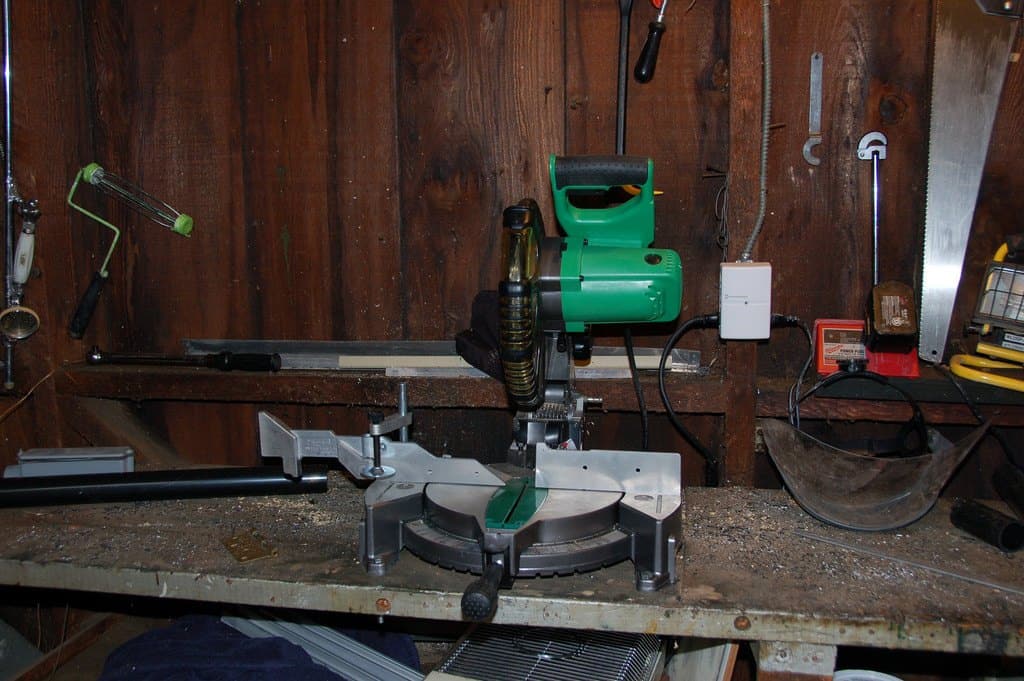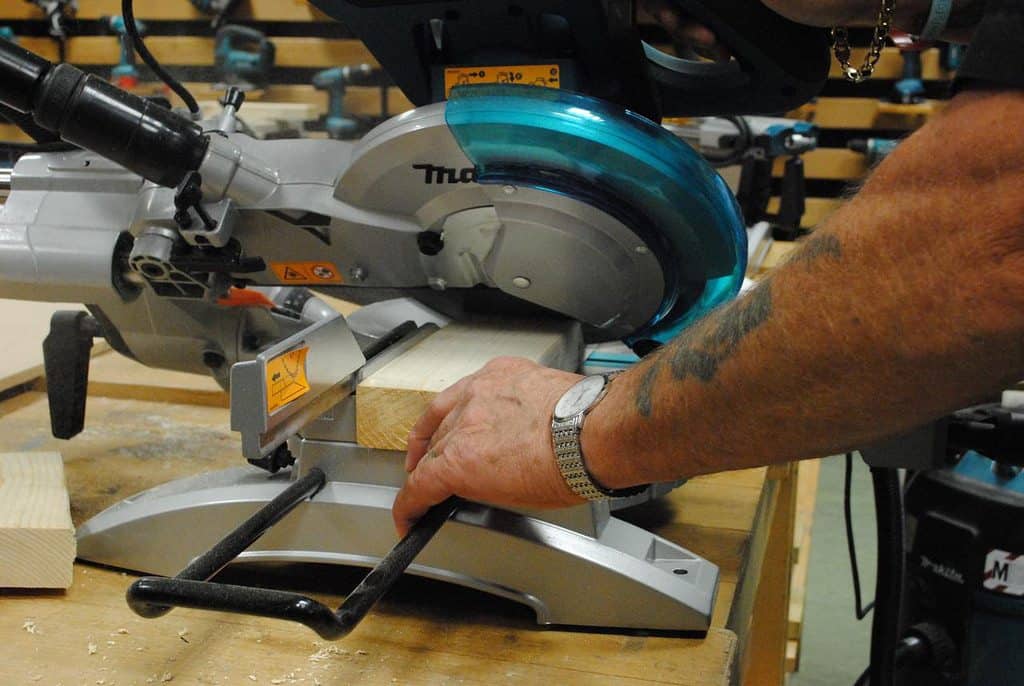Many people confuse chop saws and miter saws. In terms of appearance, they look pretty identical to the untrained eye. Both saws have round blades that are mounted on a hinged arm. These are set on a static base to support the material you’re working with.
However, despite their similar appearance, the purpose of each saw is very different, and you’ll probably find that you don’t need a chop saw for what you’re working on.
| Feature | Chop Saw | Miter Saw |
|---|---|---|
| Primary Use | Cutting hard materials like metal | Woodcrafts, carpentry, and thin sheet metal |
| Cut Type | Only 90-degree straight cuts | Variety of angles, including 90-degree cuts |
| Power | More powerful | Powerful enough for most DIY projects |
| Accuracy | Less accurate | More accurate and precise |
| Operation Safety | More hazardous, recommended for professionals | Easier and safer to operate |
| Versatility | Less versatile, mainly for straight cuts | Highly versatile for various angled cuts |
Miter Saw Overview
Lets first start by looking at the miter saw and defining its characteristics, and when you would want to use one.
What is a Miter Saw?
A miter saw is a power saw with a circular blade that is used to make straight, downward cuts. The miter saw is very similar to the circular saw in that they both use circular blades to chop their way through the material. Miter saw blades can be easily changed when worn out.
One of the main distinguishing characteristics of a miter saw is that its axis or shaft swivels, enabling you to cut at a wide array of angles. When you want to make beveled or mitered cuts, a really good miter saw is the right tool for the job.
Although both saws look very similar, there are distinct differences, including the fact that you can use a miter saw in the same way as chop saws but not the other way around.

When Should You Use a Miter Saw?
Miter saws are generally preferred by DIY enthusiasts because they are versatile, easy to use and safer than more commercial chop saws. Miters have a much wider degree of versatility and usability around the various house projects that a homeowner runs into. Check this DEWALT DW715 15-Amp 12-Inch.
Miter saws make highly accurate cuts, and can cut at a variety of angles. When would you need to use one?
- Cutting crown molding and baseboard
- Picture frames
- Door frames
- Window casing
In short, anytime you need to make an angled cut, you’ll want a miter saw.
Different Types of Miter Saws
There are a lot of different reasons to own and use a miter saw, and a lot of different comparisons with other saws. Very generally speaking, a miter saw can do all of the same cuts as the circular saw and the chop saw, but more accurately.
There are a lot of different variations on the saw, such as the compound miter saw, sliding miter saw, and the single bevel vs double bevel saw. I’ve dedicated a unique article to each topic, so I encourage you to dive into any of them if you have interest.
It doesn’t take long to realize the value of a good miter saw. They are invaluable for cutting angles, and quickly will become a favorite in your garage.
This saw can also double up and serve other needs. While it isn’t a true table saw, you can use the miter for a lot of the same functions that you would use a table saw for.
In addition, if you have a circular saw lying around, you might be interested in trading it in for a miter. You can use one for the same cuts, and it is faster and more accurate. The only downside is that the miter isn’t as portable, since it isn’t handheld.
Chop Saw Overview
Lets dive into what a chop saw is and what it is best used for.
What is a Chop Saw?
Just like miter saws, a chop saw is a power saw with a circular blade that is used to make straight, downward cuts. Chop saws can not rotate to cut at angles – it can only cut material at a downward angle.
The blade of a chop saw is afixed along a vertical axis. This allows it to cut very accurately. You put your material under the blade, turn the saw on, and lower the chop saw through the cut with your hand.
Chop saws allows you to make 90-degree crosscuts by pulling down the abrasive disc in a plunging action. These are highly versatile for a wide range of jobs including cutting window trims or 2x4s, however they are most often used to cut metal.
What is a Chop Saw Used For?
A chop saw is generally used by contractors and metal workers to cut very thick wood or metal. It is very powerful. Check this DEWALT 12-Inch Sliding Compound Miter Saw.
It generally is not a general DIY tool, as a miter saw is more accurate, and you don’t need the extra power for general cuts.
The reason chop saws can be used for cutting very hard materials like sheets of metal is because it has a powerful motor behind its cutting action. It also has an abrasive disc that resembles a grinding wheel for heavy-duty cutting, without shaped cutting edges or teeth.
Miter Saw vs Chop Saw
Although there are distinct similarities between the miter saw and chop saw, they are quite different in purpose. Lets look at the main similarities and differences in the two saws.
Similarities
- Some miter saws and chop saws have blades that enter the cut from above, also known as drop saws
- Both saws can make straight, 90 degree cuts
- Both saws can cut a variety of material (although the chop saw is better a cutting hard materials like metal
Differences
- Chop saws can ONLY make 90 degree cuts, whereas the miter saw can cut at a variety of angles, including 90 degree cuts
- There are many variations of miter saws but there is only one type of chop saw
- Chop saws are more powerful than miter saws, although the miter is plenty powerful for the majority of DIY projects
- Miter saws are more accurate than chop saws
Both saws can both cut wood as well as metal although to varying degrees. The chop saw is generally used on building sites and construction projects, whereas the miter saw is more associated with woodcrafts and carpentry.
In terms of operation, the miter saw is much easier, and safer, to operate than a chop saw. It is also more flexible in that it can cut a wide range of angles. A chop saw is restricted to straight or 90-degree cuts only.
One advantage of a chop saw is that it cuts a wider range of materials than a miter saw, which is more designed to cut wood and thin sheet metal such as aluminum.
A miter saw is a lot more accurate and precise in its cuts.
A miter saw is generally stationary while its saw head moves, whereas lumber needs to be fed into a chop saw making it much more hazardous to use. It is generally recommended that chop saws be operated by skilled professionals because of the safety issues they present.

Can I Use a Chop Saw as a Miter Saw?
Yes, you can use a chop saw for some of the cuts that a miter saw does. Chop saws are used for straight plunge cuts, while miter saws can be used for straight and angled cuts. If you just need to make straight, 90 degree cuts, then a chop saw will perform the same as a miter saw.
Can a Chop Saw Cut Metal?
Provided you have a metal cutting blade, a chop saw is the perfect saw to cut metal of all shapes and sizes. With harder metals, it is important to clamp your metal workpiece down before you make a plunge cut with the chop saw.
Is a Chop Saw Better than a Miter Saw?
Miter saws are a more robust saw than a chop saw. A chop saw is a simpler tool than a miter saw, as it can only make one kind of cut. Miter saws are a lot more diverse and can make angled and straight cuts.
Final Verdict
Unless you are a contractor or metal worker, you’ll prefer the miter saw. It is far more versatile than a chop saw, and you make very few sacrifices by opting for one. You can still cut lighter metals, and you really don’t need the extra power that a chop saw brings.
All you have left to do is decide on a 10″ vs 12″ miter saw, and you’ll be set.
